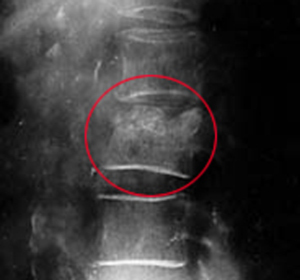
Lower back pain in the English-language sources call the pain in the lower back (low back pain). Pain often carries the tension in the lumbar spine, the restriction of freedom of movement and antalgic scoliosis. Acute back pain take a few days to several weeks.
Causes, incidence, and risk factors for back pain
Back pain hits almost everyone at least once in your life. It should be noted that the pain can occurs in any part Of the back, but, but, pain in the lumbar spine most commonly. This is due to the fact that on the lumbar vertebrae, the maximum load of your body weight.
Back pain is on the second place by the number of visits to a doctor immediately after virus infections.
You can lower back pain after lifting a heavy, sudden movement after he is in the course of time in one Position or after an injury of the spine.
Acute pain in the lumbar spine is most commonly caused by the displacement of the intervertebral disc and spinal injuries.
Causes for lower back pain:
- Osteochondrosis of the lumbar spine
- Intervertebral hernia, protrusion and intervertebral disc
- Spondylarthrosis
- Spondylosis
- Spondylolisthesis
- Compressive fracture due to osteoporosis, multiple myeloma, hemangioma vertebra
- The Tumor in the Lumen of the spinal canal
- Fracture of the spine after injury
- Prolonged Muscle Tension
- Anatomically vertebrae narrow channel
- Curvature of the spine (scoliosis, kyphosis, kyphoscoliosis, Scheuermann's disease Mau)
- Aortic aneurysm
- Rheumatoid Arthritis, Psoriatic Arthritis, Osteoarthritis
- Infection of the spine - Osteomyelitis, discitis, tuberculosis of the spine
- Pyelonephritis, Urolithiasis
- A difficult course of pregnancy
- Gynecological diseases (endometriosis, ovarian cyst, ovarian cancer, etc.)

Symptoms of pain in the lower back (lower back pain)
Pain can be many and varied: acute, dull, drawing , burning, running through a tingling sensation down the back and numbness.
The intensity of the pain in the lower back can vary from mild to excruciating pain that prevents even the slightest movement. The pain can be combined with the pain in thigh, pain in leg, pain in the foot rail.
Diagnosis of pain in the lower back
First, you need to see a doctor-neurologist. The doctor will ask you questions about the nature of their pain, its frequency and repeatability. The doctor trying to find the cause of the pain, determine and begin the treatment of simple methods (ice, moderate pain relievers, physiotherapy and exercises).
In most cases, such treatments lead to a reduction in the pain in the back. During the visit the doctor the exact location of the pain will recognize, charisma, neurological reflexes. Most people with lumbar pain recover within 4-6 weeks.
The diagnosis includes magnetic resonance imaging (engl. MRI) of the lumbar spine, computed tomography of the lumbosacral spine, x-ray of the spine.
Since the most common cause of back Intervertebral herniation of the lumbosacral spine, the first is pain, which is an MRI of the lumbar spine have to do. This research will also help eliminate most of the causes of pain, such as a Tumor in the Lumen of the spinal canal, tuberculosis of the spine, fracture of the spine, myeloma, anatomically narrow spinal canal, spondylolisthesis, various shape of curvature of the spine, spondylosis and spondylarthrosis. If Your neurologist tells you a MRI, then you do it yourself. Performance of the MR-device should TESLA 1, and more.

Non-diagnostic x-ray tubes and computed tomography, are launching this methods are unsafe. You can primarily only in cases of suspected fracture of the spine
Here are some tips on what pain do for back are:
- They reduce physical activity in the first two days after the beginning of the attack. This will help to reduce the symptoms of the disease and swelling in the area of pain.
- Do not sit with the tilt forward until the pain completely subsides.
- Take painkillers only in case of unbearable pain. Better intra make intramuscular injection, to drink as an anesthetic. This protects the wall of the stomach from direct contact with anti-inflammatory agents. Try to avoid excessive intake of drugs. Do not use for the treatment of hormonal agents, if back pain is not associated with autoimmune disease.
- Sleeping in a fetal Position, place a pillow between the feet. If you usually sleep on your back, place a pillow under the knees
- A common misunderstanding is the idea is that you need to restrict physical activity for a long time. Bed rest is not recommended!!! If you do not have a temperature increase, weight loss, involuntary urination and defecation, then you should stay active to survive as much as possible. Reduce your activity only in the first two days after the occurrence of the pain. You can start light Aerobic exercises. Walking help float on the treadmill, improve the flow of blood to the muscles Of the back. Talk with your doctor for the selection of the exercises, not to an amplification of the pain syndrome.
Forecast:
Most people feel much better after the first week of treatment. After 4-6 weeks, a large part of the patients disappears the pain completely.

In which cases you need to consult a doctor immediately:
- Back pain combined with pain in the Shin and pain in the foot
- The pain can serve you not themselves
- The pain is combined with urinary and fecal incontinence
- The combination of lower back pain with numbness in buttocks, hip, leg, foot, groin
- If you already have pain in the back before
- If the pain lasts more than 3 days
- If you are taking hormones
- If the pain is caused in the lower back after an injury
- Previously, the diagnosis of an oncological disease
- If you lost weight lately for unknown reasons





































